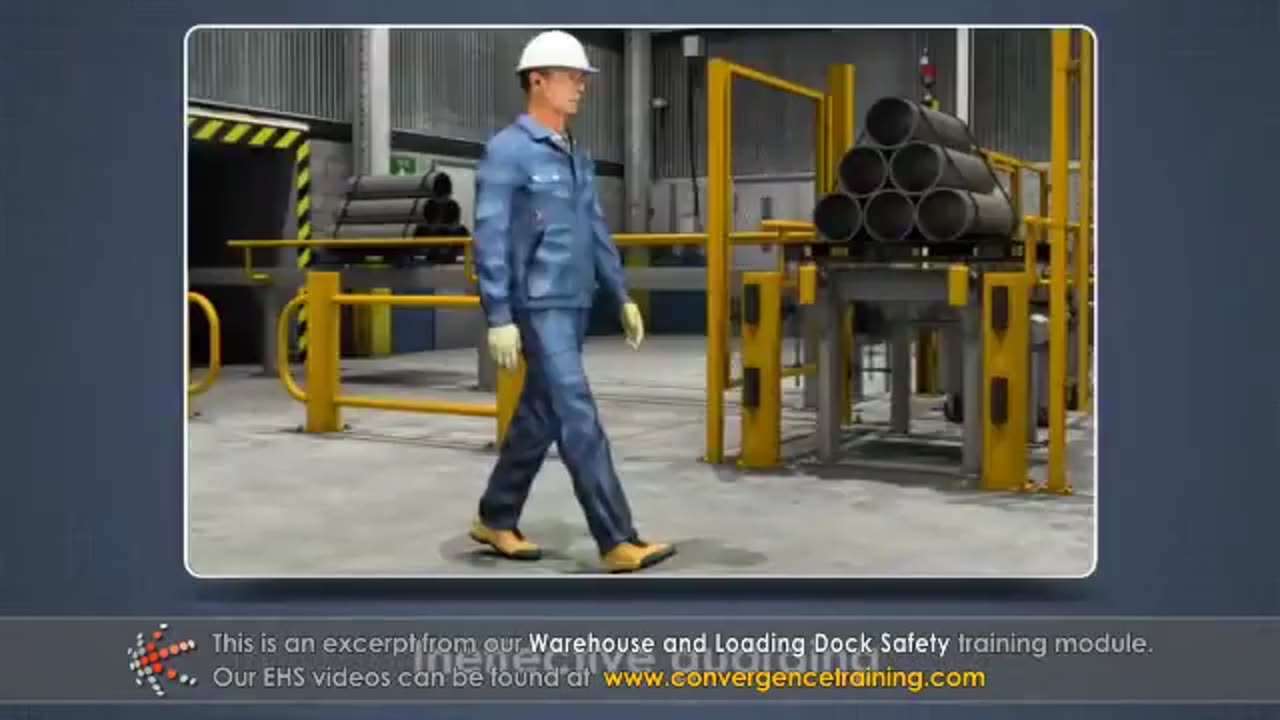Premium Only Content

Warehouse and Loading Dock Safety Training
### **Warehouse and Loading Dock Safety Training Outline**
This training focuses on minimizing risks and promoting safe practices in warehouse and loading dock environments, which often involve heavy machinery, high traffic, and potential hazards.
---
### **1. Introduction to Warehouse and Loading Dock Safety**
- **Purpose of training:**
- Ensure a safe work environment.
- Reduce injuries and accidents related to warehouse and loading dock operations.
- **Common hazards in these environments:**
- Moving equipment (e.g., forklifts, pallet jacks).
- Slip, trip, and fall risks.
- Falling objects and improper stacking.
- Vehicle and pedestrian collisions.
---
### **2. General Warehouse Safety Practices**
- **Housekeeping:**
- Keep aisles, stairways, and work areas clear of obstructions.
- Clean up spills immediately.
- **Proper stacking and storage:**
- Stack materials securely and evenly.
- Heavy items at the bottom, lighter items on top.
- Avoid overloading shelves or pallets.
- **Lighting and visibility:**
- Ensure adequate lighting throughout the facility.
- Use mirrors and warning signals in blind spots.
---
### **3. Personal Protective Equipment (PPE)**
- Overview of required PPE for warehouse and loading dock areas:
- Hard hats for falling object protection.
- High-visibility vests for workers near vehicles.
- Steel-toed boots to protect against falling loads.
- Gloves for handling sharp or heavy materials.
---
### **4. Material Handling Equipment Safety**
- **Forklifts and Powered Industrial Trucks (PITs):**
- Operator certification and regular safety checks.
- Follow speed limits and maintain clear visibility.
- Never carry passengers or exceed load limits.
- **Pallet jacks and dollies:**
- Check for wear and tear before use.
- Push, don’t pull, to reduce strain.
- **Cranes and hoists:**
- Ensure proper rigging and weight capacity adherence.
---
### **5. Loading Dock Safety**
- **Dock edges and falls:**
- Use dock plates, bumpers, and barriers to prevent falls.
- Never walk or stand on the edge of the dock.
- **Trailer and truck safety:**
- Secure trucks and trailers with wheel chocks or dock locks before loading/unloading.
- Ensure trailers are stable and not overloaded.
- **Communication and awareness:**
- Use hand signals or radios to coordinate loading/unloading activities.
- Be aware of the movement of forklifts and pedestrians.
---
### **6. Safe Lifting and Material Handling**
- **Manual lifting techniques:**
- Bend at the knees, not the waist.
- Keep the load close to the body.
- Avoid twisting while lifting.
- **Team lifting:** Use help for heavy or awkward loads.
- **Mechanical aids:** Utilize forklifts, pallet jacks, or conveyors to reduce strain.
---
### **7. Traffic Management in the Warehouse**
- **Designated pedestrian walkways:**
- Mark lanes clearly with paint or tape.
- Install barriers where feasible.
- **Vehicle flow management:**
- One-way systems to reduce congestion.
- Use warning lights, horns, and mirrors for visibility.
- **Speed limits and stopping zones:**
- Enforce speed limits for forklifts and vehicles.
- Clearly mark stopping points near intersections.
---
### **8. Hazardous Materials and Spill Control**
- **Storage of hazardous materials:**
- Follow OSHA and HAZMAT guidelines.
- Store chemicals in labeled, approved containers.
- Maintain Material Safety Data Sheets (MSDS/SDS) for all hazardous substances.
- **Spill response:**
- Use appropriate spill kits.
- Evacuate the area if necessary and report the incident.
---
### **9. Emergency Preparedness**
- **Evacuation procedures:**
- Identify emergency exits and assembly points.
- Conduct regular fire and emergency drills.
- **Fire safety:**
- Proper storage of flammable materials.
- Location and use of fire extinguishers.
- **First aid stations:** Ensure accessibility and proper supplies.
---
### **10. Incident Reporting and Investigation**
- **Importance of reporting:**
- Identifying and mitigating risks.
- Preventing repeat incidents.
- **Documentation:**
- Report all injuries, near-misses, and unsafe conditions immediately.
- Maintain logs and records for regulatory compliance.
---
### **11. Hands-On Training**
- **Walkthrough of the warehouse and dock area:**
- Identify hazards and safety features.
- **Equipment operation demos:**
- Safe forklift operation.
- Proper use of dock plates and restraints.
- **Emergency response simulation:**
- Practice evacuation and spill containment.
---
### **12. Assessment and Certification**
- **Written or practical evaluation:**
- Test knowledge of safety procedures and proper equipment use.
- **Certification:**
- Provide certificates to participants who demonstrate competency.
---
Would you like this training to focus on specific equipment, or do you need additional details on emergency scenarios? Let me know!
-
 20:24
20:24
HSESafetyInformation
9 months agoKABULI PULAO RECIPE - Original 40+ KG Afghani Meat Pulau Prepared - Street Food Qabili Plav Recipe_2
38 -
 LIVE
LIVE
a12cat34dog
2 hours agoONE OF THE BEST REMAKES EVER :: Resident Evil 4 (2023) :: I GOT 100% ON EVERYTHING {18+}
151 watching -
 19:31
19:31
Liberty Hangout
3 days agoAnti-Trumpers Repeat CNN Talking Points
192K229 -
 19:53
19:53
Clintonjaws
4 hours ago $3.85 earnedThey Lied About Charlie Kirk - MAJOR UPDATE
12.2K13 -
 LIVE
LIVE
Midnight In The Mountains™
1 hour agoArc Raiders w/ The Midnights | THE BEST LOOT RUNS HERE
122 watching -
 LIVE
LIVE
ladyskunk
2 hours agoBorderlands 4 with Sharowen Gaming, Rance, and Sweets! - Part 8
40 watching -
 LIVE
LIVE
S0lidJ
3 hours ago🟢Live -S0lidJ - Solos Arc Raiders
97 watching -
 5:46:19
5:46:19
TheItalianCEO
7 hours agoSunday is for chill games
15.3K -
 10:24
10:24
AlaskanBallistics
19 hours ago $2.07 earnedDiscovery Optics 1-8x28mm LPVO Riflescope Review
13.6K -
 2:08:24
2:08:24
Jeff Ahern
5 hours ago $8.17 earnedThe Sunday Show with Jeff Ahern
22.3K6